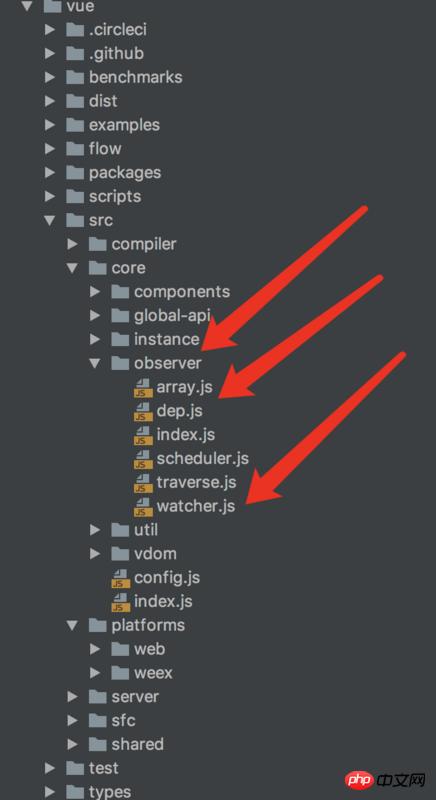vue观察模式的容易理解
时间:2024/12/4作者:未知来源:手揣网教程人气:
- [摘要]本篇文章给大家带来的内容是关于vue观察模式的简单理解,有一定的参考价值,有需要的朋友可以参考一下,希望对你有所帮助。以下是我对vue观察者模式的理解:不要对框架的偏见, 你真的了解jquery、a...本篇文章给大家带来的内容是关于vue观察模式的简单理解,有一定的参考价值,有需要的朋友可以参考一下,希望对你有所帮助。
以下是我对vue观察者模式的理解:
不要对框架的偏见, 你真的了解jquery、angular、react 等等,框架是什么只是工具而已。
你用过jquery的 trigger、on、off 事件绑定的方法吗?事实上 vue 不过也是这种模式,只不过vue 是自动调用on方法,自动触发trigger。甚至可以不用jquery对事件监听触发的实现。其实最终解释就是对某种事件的callback(基础原理)。
以下是源码目录截图:
1... vue 实例初始化时,会对data函数返回的对象里的属性调用以下方法,代码注释如下:
// 这个是 vue 绑定自动绑定事件的方法和触发事件方法, 会把data函数返回的对象变量属性,重写对应属性的 赋值 和获取的操作。具体查看 (mdn Object.defineProperty api) Object.defineProperty(obj, key, { enumerable: true, configurable: true, get: function reactiveGetter () { const value = getter ? getter.call(obj) : val // watcher 对象, 如果存在 if (Dep.target) { // 把Watcher 实例 推入 Dep 实例的 subs 数组里, 这个就相当于 on dep.depend() if (childOb) { childOb.dep.depend() if (Array.isArray(value)) { dependArray(value) } } } return value }, set: function reactiveSetter (newVal) { const value = getter ? getter.call(obj) : val /* eslint-disable no-self-compare */ if (newVal === value (newVal !== newVal && value !== value)) { return } /* eslint-enable no-self-compare */ if (process.env.NODE_ENV !== 'production' && customSetter) { customSetter() } if (setter) { setter.call(obj, newVal) } else { val = newVal } childOb = !shallow && observe(newVal) // 通知 Dep 实例 中subs 里数组 中所有 Watcher 实例, 然后调用Watcher实例里的 update方法(), 这个就相当于 trigger。 dep.notify() } })// Watcher 构造函数 constructor ( vm: Component, expOrFn: string Function, cb: Function, options?: ?Object, isRenderWatcher?: boolean )2...Watcher初始化时,会调用Dep.pushTarget方法, 把 Wathcer实例赋值到dep.js 里的Dep.target, 接着会根据 exporFn,运行exporFn 所代表的方法。这个方法里基本上包含调用 1...里的getter方法(想想render钩子里的操作基本有获取vue实例属性data里的值或者获取vue实例的计算属性的值)。
var vm = new Vue({ data () { return {msg: '找个小姐姐!'} }, // 相当于 exporFn render(h) { return h('h3', {}, // 这里面就会调用 msg 对应的 getter方法 this.msg ) } })所以就会使 render 函数 与 Vue 实例 的 数据 data属性 和观察属性等产生联系,这就形成一个闭环。当其中的属性变化,就会自动调用 setter 方法,从而触发dep.notify 方法,进而又会触发 dep.subs 里的 Watcher 实例调用 update方法,进而更新。
(这部分代码不知如何说,故此没写, 具体查看源码)以上就是vue观察模式的简单理解的详细内容,更多请关注php中文网其它相关文章!
网站建设是一个广义的术语,涵盖了许多不同的技能和学科中所使用的生产和维护的网站。
关键词:vue观察模式的容易理解